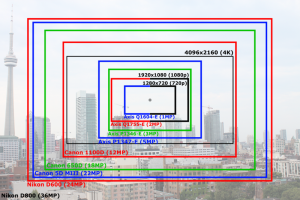Tech
D-SLR Camera or IP Camera for a timelapse project ?
First, keep in mind that a timelapse project is a unique event. For a construction project for example, your building will be built only once, it will be impossible to come back to capture other shots later. As a result you need a (very) good image quality and a (very) reliable capture device to be sure not to miss any aspects of your project.
Ask yourself a simple question, would you your photographer to take pictures of your wedding with a mobile phone or with a DSLR camera ?
Answer this question and replace “mobile camera” with “IP camera”. Even this comparison is not good enough as today’s high end smartphones are equipped with better sensors than most IP cameras.
I’m not saying IP cameras are bad (especially as it is the base of our Webcampak Cloud offer). IP cameras are great, they can be used to send pictures on the network at a high framerate (FPS) none of the DSLR cameras on the market can match. But IP cameras are video cameras, they haven’t been create to take pictures. And for a timelapse what we first need is pictures, captured at a very low framerate (one picture very 10mn for example).
So why would someone use an IP camera instead of a DSLR camera for a timelapse project ?
- First, cost, most IP camera are less expensive than a low range DSLR camera. You could easily find DSLR lenses more expensive than IP cameras. You can find outdoor IP cameras as low as 135 euros (incl. TAX).
- Another advantage of IP cameras are their potential reliability and ease of installation. An IP camera is usually smaller and due to an absence of mobile parts (the shutter for a DSLR camera), their reliability is expected to be higher.
An IP camera is therefore a simple, low-cost and fast way of implementing a timelapse for a small budget project where quality is not key.
But when it comes to comparing picture quality, IP cameras cannot stand the comparison. There are three elements directly involved in image quality:
- Capture definition/resolution, defined in megapixels
- Quality of the sensor
- Quality of the lens
First, definition. High end IP cameras max at 5 MP (8MP for some) where DSLR cameras max at 36MP.
High definition brings the following benefits:
- Future-proof: in a few years time, you may want to re-use your timelapse project, but at that time, it’s likely that 1080p which is today’s standard will be outdated. With a very high definition you could always re-use your project on high definition display, such as 4K (4096x2160 pixels).
- If you capture in very high definition (10MP and more), you will be able to create movements inside your picture, such as zooming or panning without impacting image quality. Higher is the definition, greater will be the possibilities.
Keep also in mind that you can downsize a pictures, but you cannot do the other way around without impacting picture quality.
To help you compare different definitions available on the market, you will find below a picture containing definition of various IP and DSLR cameras, as well as today’s video standards (720p, 1080p, 4K).
[caption id=”attachment_1764” align=”aligncenter” width=”300”] Definition comparison[/caption]
Definition comparison[/caption]
A timelapse video captured with a Nikon D800 (36MP sensor) will contain 18 times more information than a timelapse video captured with a 2MP IP Camera. It’s like installing 18 2MP IP cameras next to each other.
Then, regarding sensor quality, as mentioned previously, IP cameras have not been created to capture pictures but videos. An IP camera cannot adapt it’s exposure time to always changing environment, it will simply capture a video stream and eventually post-process it with an internal correction software.
In difficult conditions, IP cameras will often capture bad to very bad pictures, the easiest way to spot this on is to capture night pictures (or dawn). Let’s have a look at one of our test bench where we have an IP camera and a compact camera capturing the same view.
[gallery link=”file”]
During the day, in good conditions and in low resolution, it can be difficult to spot differences, but by night the difference is easy to spot. Just for a comparison we also added a picture captured yesterday by our Webcampak (18 MP camera) installed in Toronto.
Finally, quality of the lens is also a key element, and again, DSLR cameras have a very wide range of options (and prices).
So, what should be the conclusion of this article ?
Keep IP cameras as an option. As compact cameras have their own space in digital photography market, IP cameras have their own space in timelapse market. They offer a very good solution for low budget projects where quality is not a key element.
This is the reason why we created Webcampak Cloud, giving you options to create your timelapse project for as little as 50 euros +TAX per month.
But if you want an high definition video that would “wow” your clients with impressive video effects and cristal clear picture quality, then a DSLR based timelapse video is, for sure, the way to go.
This article has been automatically imported from our old blog, there might be formatting or layout issues.
TECH
